Free shipping for all orders over 35 euro!
-
Shop
- Insights
-
About ROMBO
- Dealers
- Guitar Pick finder
- Gift Card
+Categories
- accessories
- bass
- bass pick
- bass picks
- bass plectrum
- bass plectrums
- beginner
- bright tone
- chose guitar pick
- chose guitar picks
- chose plectrum
- chose plectrums
- CrystalBright
- Diamond
- Diamond pick
- discipline and guitar
- DIY generation
- durability pick
- durable pick
- eco
- ecoblack
- find guitar pick
- find plectrum
- fingers vs picks
- grip
- grip guitar pick
- guitar accessories
- guitar advantages
- guitar benefits
- guitar career
- guitar health
- guitar injury
- guitar learn
- guitar lesions
- guitar lesson
- guitar method
- guitar noise
- Guitar noise plectrum
- guitar pain
- guitar pick
- guitar pick beginner
- guitar pick bevel
- guitar pick buy
- Guitar pick diamond
- guitar pick durability
- guitar pick durable
- guitar pick eco
- guitar pick features
- guitar pick grip
- guitar pick material
- Guitar Pick Noise
- Guitar Pick online
- guitar pick recycled
- guitar pick recycled material
- guitar pick special features
- guitar pick textures
- guitar pick thickness
- guitar pick variable thickness
- guitar picks
- guitar tone
- guitar warm-up
- guitarpick
- guitarpicks
- hold a guitar pick
- hold guitar pick
- hold guitar picks
- hold pick
- hold plectrum
- hold plectrums
- how to
- how to chose your guitar picks
- jazziii
- learn guitar
- lose guitar pick
- material
- materials
- mental health and guitar
- motivation and guitar
- music
- not to lose guitar pick
- Online guitar
- online guitar pick
- online guitar pick buy
- pick
- pick durability
- pick material
- pick noise
- Picks
- picks vs. fingers
- play bass fingers
- play bass picks
- play bass with fingers
- play bass with pick
- play bass with picks
- play bass with plectrum
- play guitar faster
- plectrum
- plectrum attributes
- plectrum beginner
- plectrum bevel
- plectrum characteristics
- plectrum features
- plectrum grip
- plectrum material
- plectrum noise
- plectrum recycled
- plectrum shape
- plectrum variable thickness
- plectrums
- Plek
- pua
- recycled
- recycled guita pick material
- recycled guitar picks
- recycled picks
- recycled plectrum
- Rombo Diamond
- rombopicks
- tendonitis guitar
- the guitar pick
- tone
- variable thickness
- warm tone
- warm-up guitar

7 Essential Guitar Pick Techniques
One of the most valuable skills when it comes to guitar playing is versatility.
Versatility allows you to adapt to different environments and enriches your playing, making a difference in the final result.
Music is about staying dynamic and monotony kills dynamic. Therefore, the most logical step for you as a guitarist is to expand your repertoire of guitar skills to keep that vital, engaging sound that makes music so joyful.
If you have decided to use a guitar pick for playing guitar, there are seven techniques that are a must.
They will take time to learn and master, but believe me, they make the difference.

1- TREMOLO PICKING:
If you have listened to the music of the last 70 years, you can probably recognize this guitar technique in most rock classic hits.
Tremolo is an Italian word which means “to shake” or “to tremble”.
In the context of guitar, it involves striking one (sometimes more than one) guitar string very fast with alternating strokes. Therefore, this technique is a form of alternate picking. Tremolo picking is very easy to learn but it requires strong discipline and practice to master.
Tremolo picking is essentially useful for any style of music and obviously a big part of the surf guitar sound (I’m a big fan of it!).

In guitar literature, sometimes the words tremolo and vibrato are reversed. This technique has nothing to do with a “tremolo bar” or a "tremolo effects box".
WHY IS TREMOLO PICKING IMPORTANT?
If one of your long-term goals in your guitar learning process is to increase speed, tremolo picking is a good place to start.
It is not only very fun but also can add new textures and some dynamics to your compositions. You would be surprised how well this technique fits even in metal or hardcore music.
A FAMOUS SONG WITH TREMOLO PICKING:
The surf rock version of the song “Misirlou”, from Dick Dale, is probably the greatest example of tremolo picking. The original one is a traditional song from the Eastern Mediterranean area dating back to 1927!
The version of Dick Dale got very popular after appearing in the soundtrack of Pulp Fiction in 1994.
BEST PICK FOR TREMOLO PICKING:
The most influential factors when choosing the best guitar pick for tremolo picking are thickness, material, and grip.
It’s important to have a snappy, responsive guitar pick. For this, medium picks with a medium/pointy tip are my recommendation.
However, there is no consensus in the guitar world for this. Many players have reported preferring thick, rigid picks.
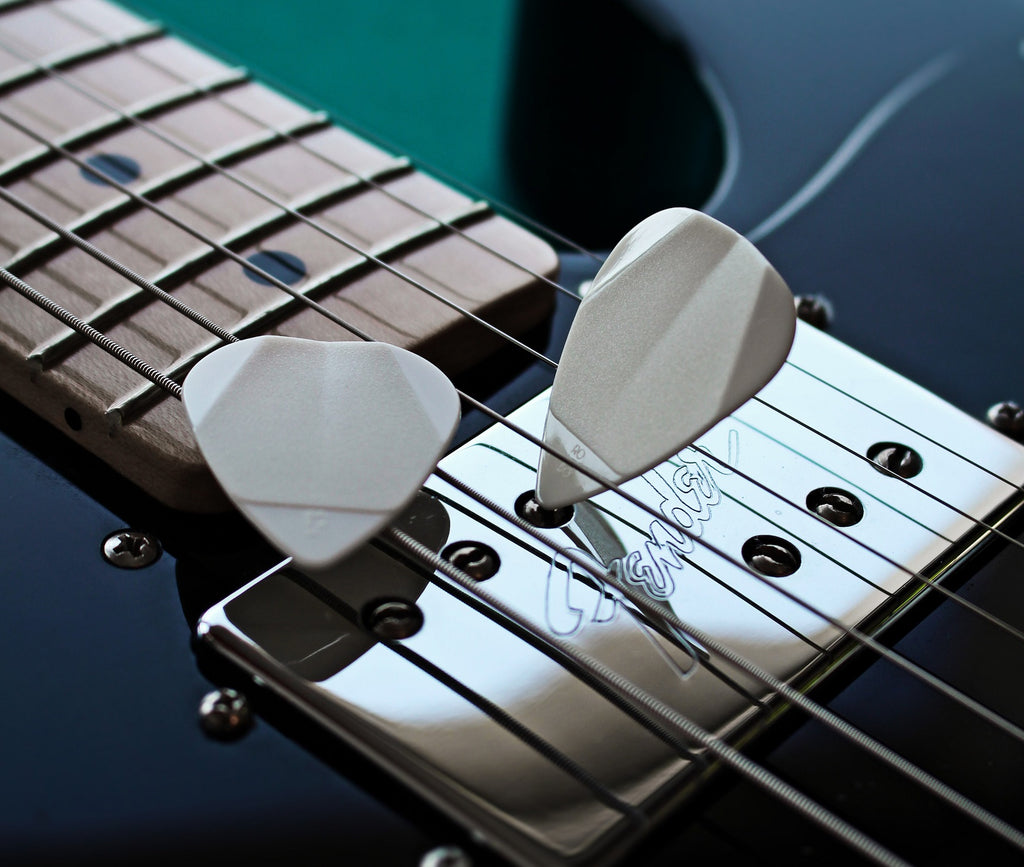
In my case, I have found the best stability and speed using Rombo Origami. This pick can be described as: Flexible but still rigid enough for note control. Right amount of flexibility for a snappy fluid attack that's bright and crisp. The concave surface on the hold area ensures an ergonomic and comfortable hold.
Everyone’s hand is a little different in how they hold the pick and move. The best way to find out is to test different shapes and thicknesses, and then try them out
Good luck!
2- PICK SLIDES:
One very extended technique often performed in the rock, metal, and punk genres is pick slides or pick scrapes.
By holding the edge of the guitar pick against the guitar strings and moving it along the edge, the pick catches the strings’ windings, causing the strings to vibrate and produce a very pleasant textured noise.
Usually, guitar pick slides start near the bridge and end over the higher frets. However, there are countless variations of pick slides depending on the direction, the angle of the pick relative to the strings, and other variables.

Unfortunately, performing pick slides completely ruins the edges of the guitar pick, especially on thinner ones. This won’t directly affect the tone or control of the plectrum, but the damaged sides will develop some dents.
What makes a guitar pick durable? Find our here.
WHY ARE PICK SLIDES IMPORTANT?
Guitar pick slides are not the most relevant aspect of your playing. Nevertheless, a correctly performed slide in the right place will add so much to the moment.

The noisy textures produced by this technique are the perfect weapon of choice for songs using high distortion levels.
A FAMOUS SONG WITH PICK SLIDES:
The first use of the pick slide is attributed to Bo Diddley and can be heard in the opening of his song "Road Runner" from the 60s.
Today, some guitarists have taken this technique to a new level and have created signature variations. A shining example of pick slides from the last years is the metal band Gojira with their famous signature “Gojira-Scrape” that was created by accident and combines several guitar pick techniques
BEST PICK FOR PICK SLIDES:
If you are going to do pick slides frequently, then you need to consider two things:
- Using durable guitar pick materials, and
- Using thick picks.
Otherwise, your guitar picks will be inoperative after a couple of sessions. The dilemma is that most players get better noisy sounds with a medium guitar pick.

I have found a solution that works for me: medium-heavy picks that are large enough to scrape with higher areas of the pick that won’t touch the strings. From our picks, I prefer Rombo Horizon the most for pick slides. Also, the curvy edge creates different pressure on different strings and that’s nice.
3- PINCH HARMONICS:
Do you know any guitar player who does not like pinch harmonics? I do not either.
Pinch harmonics are created by the picking hand. Playing this technique produces high-pitched tones. This phenomenon occurs when you stop a part of the string vibrations in the right position and create a "node".

There is a simple way to test this; pick a note and apply a small pressure anywhere on the string such that the vibration doesn’t stop completely.
WHY ARE PINCH HARMONICS IMPORTANT?
Pinch harmonics are often related to high gain tones and metal music but they are a powerful tool to add dynamics and textures to any genre of music or type of guitar; electric or acoustic.
It is considered one of the most abstruse techniques for intermediate players. Common problems are pinch harmonics that aren't loud enough or additional noises that make the harmonics not sound clean enough.

Root causes of this problem can be:
-
the guitar player does not know the right places on the strings to play pinch harmonics
-
there is unwanted noise coming from unmuted strings
-
the pinch harmonic is produced isolated, without combining it with other techniques like vibrato.
Most guitar players (including me) played their first pinch harmonic accidentally.
A FAMOUS SONG WITH PINCH HARMONICS:
Guitarist Billy Gibbons from ZZ Top is considered the father of pinch harmonics. Not because he invented them, but because he brought them to the mainstream. Although he is a well-rounded guitarist with a focused skillset based on blues, he is best known for his pinch harmonics.
BEST PICK FOR PINCH HARMONICS:
There is no special pick to do pinch harmonics. The pinch harmonic is technically produced by the thumb of your picking hand.
However, this technique is widely used in lead guitar in combination with other advanced techniques that work especially well with thick, small guitar picks.
Therefore, although you can learn pinch harmonics using thin picks, I recommend using thick picks.
 #If you want to learn more about the differences between thin and thick guitar picks read our article "Thick guitar picks vs thin guitar picks".
#If you want to learn more about the differences between thin and thick guitar picks read our article "Thick guitar picks vs thin guitar picks".
4- PALM MUTE:
Palm mute is a very regular technique used by most guitarists. By placing the side of the picking hand on the strings close to the bridge and dampening the guitar strings (when necessary), the strings produce muted sounds.
You can control the dampening effect by moving your hand to a different position further from the bridge.

Although this technique isn't seen as a very difficult one, these are common mistakes that prevent players from learning it properly:
- wrong hand position
- not having a relaxed posture
- problems by keeping a stable tempo
- too much pressure on the strings
WHY IS PALM MUTE IMPORTANT?
As a guitarist or bassist, you are always on the lookout to make your music sound natural, creative, and exciting.
Palm-muting is a great skill for dynamic control exercises. This means you will automatically learn how to shape your sound using fluctuations in volume and intensity.
With this skill in your repertoire, your music will sound more vocal and dynamic.
A FAMOUS SONG WITH PALM MUTE:
This technique is very old. As old as the invention of the electric guitar (1936). Most classical players have been using it for centuries with all kinds of instruments.
Today, palm muting is widely used in heavy metal, thrash, speed, and death metal. It is often found in music that features distortion effects.
Is there any good song to practice palm muting for getting better at it? “Master of Puppets” from Metallica—it’s a masterclass in palm muting and down picking.
BEST PICK FOR PALM MUTE:
I recommend using a thick guitar pick for this. They provide high volume, a broader dynamic range, and more control over single notes (in case you use palm mute arpeggios). In addition, palm muting is a demanding technique that causes a lot of guitar pick wear. As you might know, thick guitar picks are more durable.

My favorite choice for this technique is Rombo Diamond.
5- PICK STRUMMING:
Guitar pick strumming is a way of playing guitar. A strum is a sweeping action where a pick (or finger!) brushes over the guitar strings and generates sounds.
For most guitar players, this is the first technique they learned and the technique that caused most headaches as a beginner.

Learning how to strum correctly takes time and practice. Most beginners lack the necessary muscle memory it takes to play while remaining relaxed or having a good posture.
WHY IS PICK STRUMMING IMPORTANT?
In many ways, understanding this skill is essential for understanding guitar. Great strumming skills mean being a great rhythm guitarist. Therefore, this should be your number one goal as a beginner.
Learning chords is important, but they are just static shapes. The diversity of the hundreds (if not thousands) of strumming patterns available will inject musicality and rhythm into your playing.
A FAMOUS SONG WITH PICK STRUMMING:
“Bad moon rising” by Creedence Clearwater Revival, is a good place to start. It combines easy chords (D, A, G) with a very simple progression and a very catchy, bluesy melody.
BEST PICK FOR STRUMMING:
My best advice for beginners is to start with a very thin guitar pick. It can help to practice with something below 0.6 that’s nice and bendy. As you improve your skills, you can try with thicker picks, as they will add more bass to your tone.

For all the beginners out there, my best choice would be Rombo Classic.
However, if you are in the very beginning of your guitar journey, please read this article where I explain, why starting with medium guitar picks can be a better choice for you. "Medium Gauge Guitar Picks".
6- DOWNPICKING
Downpicking or down-stroke picking is a very beloved guitar technique in which the player moves the guitar pick only in a downward motion. The tip of the pick does not brush the strings as the hand moves back to the original position for the next down-stroke.
It is one of the most underrated skills on guitar and although performing this technique might seem easy, the required endurance for long passages with fast tempo is very often a problem even for advanced guitarists.

WHY IS DOWNPICKING IMPORTANT?
But first, why would you want to remove the upstrokes (alternate picking) and then increase the necessary effort for the same number of strokes? Why would you torture your wrist muscles in this way?
This technique is widely used in metal and punk guitar and the main reason is that when mastered, downpicking can make the guitar’s sound very powerful and rhythmic.
A FAMOUS SONG WITH DOWNPICKING:
Famous punk guitarist Johnny Ramone used this technique in the mid-70s in combination with fast tempo (180 to 200 bpm). The technique was very innovative at that time and influenced many current guitarists like James Hetfield who has been regarded as “the King of Downpicking”.
Many beginner guitarists start with songs from Ramones because of their simplicity in terms of chords and lack of tempo variations.
BEST PICK FOR DOWNPICKING:
For downpicking, there is a basic rule: the more mass the guitar pick has, the thicker and more aggressive the sound.

Therefore, a thick, large guitar pick with a pointy tip will be the loudest and most rhythmic one.
I recommend Rombo Diamond.
7- HYBRID PICKING
The interesting thing about hybrid picking is the fact that the player uses a plectrum as well as one or more fingers. This can be done alternately or simultaneously.
Typical styles for this technique are rockabilly guitar, country and bluegrass, and more classical passages with acoustic or classical guitar.
Hybrid picking can be very hard if you are a beginner. Before you think of learning this technique, you will have to learn how to play with your fingers and with a guitar pick. This is a requirement you cannot avoid.

WHY IS HYBRID PICKING IMPORTANT:
Three major arguments should convince you to learn hybrid picking:
Tone diversity:
The pick is generally used to play bass notes with a longer duration and very noticeable timbral differences caused by variations in the vibration of the strings. Therefore, your playing will sound more interesting combining pick and fingers.
Timing:
Hybrid picking allows you to pick two to four strings simultaneously. This makes it very different from strumming and gives an approach much more similar to piano techniques.
Flexibility:
Managing this technique, you will be able to change between fingerstyle playing and guitar pick playing within the same song or passage.
A FAMOUS SONG WITH HYBRID PICKING:
Hybrid picking was popularized by guitarists like Steve Howe some decades ago. Most players that learn this technique today start with a more classical approach.
A great song to start with this technique is “Amy” by Tommy Emmanuel. However, the complexity of the chords makes this song only possible to play for intermediate and advanced players.
BEST PICK FOR HYBRID PICKING:
There is no such thing as a “good” or “bad” pick for hybrid picking. You can use the pick you think fits the best for the song you are playing.
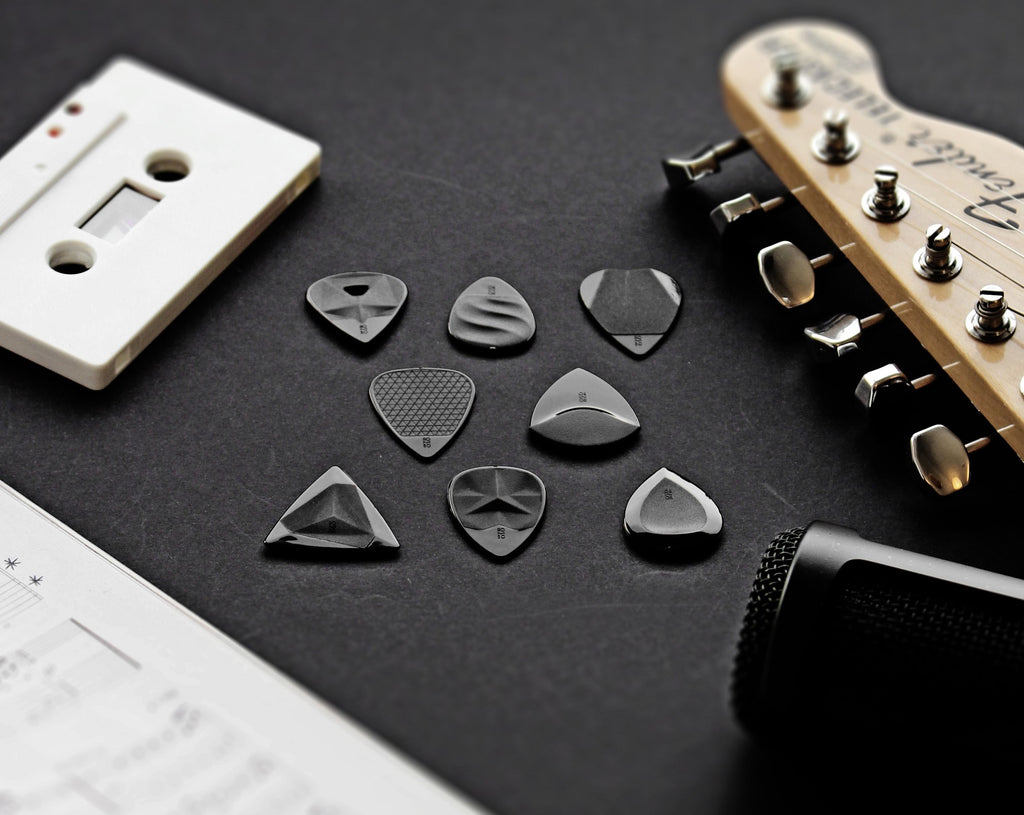
Because this technique is widely used by rhythm guitarists, there is a consensus that picks around 1 mm will perform well. However, it is up to you to try and decide which one is best for every passage.
Discover more about guitar pick thickness here.
8- BONUS SKILL – SWEEP PICKING:
For some reason, sweep picking is the trend. Every guitar forum gets new threads with this topic week after week. Perhaps it’s due to the high speed and visually nice arpeggios that make the guitar produce cyclical sound patterns and put us in a status of trance.

This technique describes the action of playing single notes on consecutive strings using the same motion, either all down-strokes or all upstrokes.
Sweep picking has been recognized as a difficult technique. It is more for advanced players and it can take years to master it.
WHY IS SWEEP PICKING IMPORTANT?
Sweep picking is used by guitarists to play arpeggios at high speed. The phrasing sounds produced by this technique sounds typical of other instruments like the piano.
Although sweep picking is a very important technique for building speed and fluency on string instruments, my advice would be to not learn this technique unless you have mastered other techniques that can give you more versatility.
Sure, it is ok to use sweep picking occasionally but that is not what you are going to play most of the time. In my opinion, a lot of bands overuse this technique. Therefore, you should reflect if the time needed to correctly learn sweep picking could be used for other more relevant skills.
A FAMOUS SONG WITH SWEEP PICKING:
Although often regarded as a “modern guitar technique”, pick sweeping has been around since the 50s. The technique was first used and developed by jazz guitarists.
Today, it is commonly used in metal but many students start with the song “Give Me the Night” by George Benson. Practicing sweep picking with clean tones can help you develop a more accurate technique.
BEST PICK FOR SWEEP PICKING:
What qualities are you looking for in a pick to perform sweep picking? Small and easy to handle, good maneuverability and stability, and good string separation. This means: Thick, pointy guitar picks like Jade or Horizon.

However, I have a bonus for you: We have received some E-Mails from professional guitarists using Rombo Prisma for their sweeping techniques, a pick that wasn’t developed for this. However, its sharp tip, combined with a very large, beveled edge, and the total “mass” of the pick (variable thickness), makes this pick a great candidate for bright tonal sweep picking solos.


Medium Gauge Guitar Picks
Medium guitar picks are the most popular choice amongst guitarists and they offer the best of both worlds, right? Well, it is not that easy.

In our last article, “thin vs thick guitar picks”, we discussed both guitar pick thickness ranges in depth. Medium guitar picks deserve a separate analysis.
1- Why does guitar pick thickness matter?
Guitar pick thickness is usually measured in millimeters and this is an attribute that can change various aspects of a pick like flexibility, tone, volume, pick noise, durability, control over single notes, and more.

The thickness of a guitar pick is for this reason considered one of the 4 fundamental attributes of a guitar pick, along with guitar pick material, shape, and size.
2- Medium guitar pick thickness:
Medium guitar picks range in thicknesses from 0.55 and 1 mm.
The following is what a survey performed in March 2021 has shown. Thousands of guitarists were asked to define the following pick thicknesses:
- The maximum thickness of a thin guitar pick
- The minimum thickness of a thick guitar pick
With both limits established, we obtain the thickness definition of medium guitar picks.

The maximum thickness of a thin guitar pick was defined as about 0.55 mm by 2.292 guitarists.
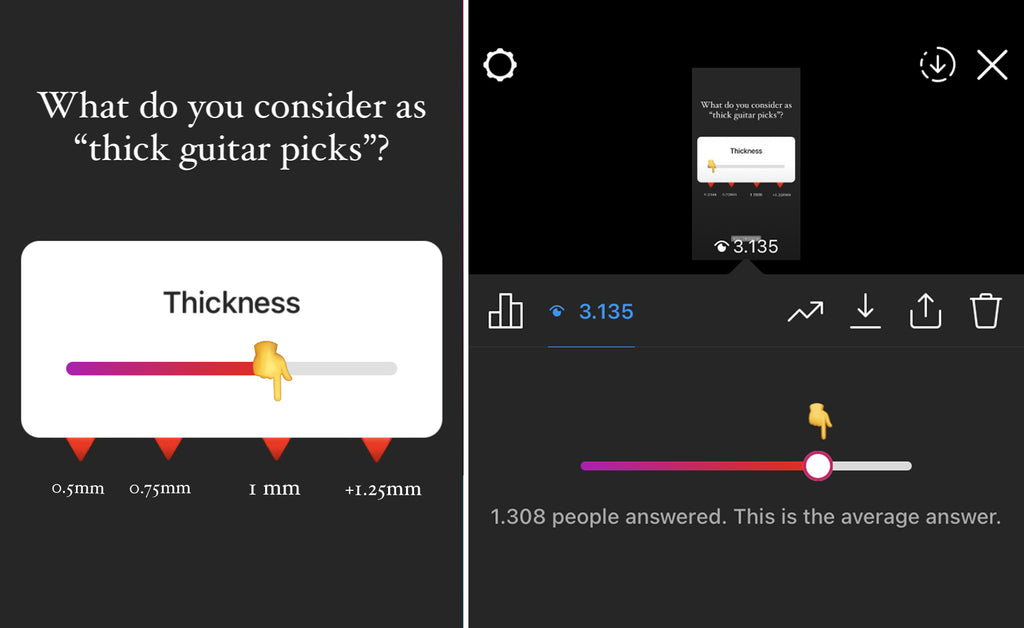
The minimum thickness of a thick guitar pick was defined as 1 mm by 1.308 guitarists.
3- What is a medium guitar pick?
Medium guitar picks are guitar picks with a thickness between 0.55 and 1 mm. These guitar picks are very popular because of their versatility; in some areas, they offer the advantages of both thin and thick guitar picks.

Medium gauge picks have the broadest flexibility range. In this pick thickness interval, the material will play the most important role when it comes to defining the flexibility of a pick.
In other words, thick guitar picks are always stiff and rigid. With thicknesses over 1 mm, even the most flexible pick materials are stiff, and therefore the material has less influence on the flexibility of the pick. This relation creates a broad flexibility range amongst medium guitar picks, which can be very flexible or very stiff, depending on the material used.

The same effect can be applied to tone, durability, and pick noise.
Typically, medium guitar picks are used by lead guitarists who also implement rhythm guitar techniques and look not only for an all-round compromise between single-note melodic phrases and strumming, but also potentially developing a more versatile guitar career that integrates different techniques and mixes both worlds together.
4- Thin, medium and thick guitar picks:
|
|
Thin guitar picks (under 0.55 mm) |
Medium guitar picks (0.55 - 1 mm) |
Thick guitar picks (over 1 mm) |
|
Flexibility |
Flexible/very flexible |
Medium flexibility or stiff, depending on the material. |
Rigid/very rigid |
|
Tone |
Lighter tones, less bass |
Warm tones for softer materials. Brighter tones for harder materials. |
Warm/dark tones and mellow tones |
|
Volume |
Maximum volume is limited. Lower dynamic range. |
Can provide high volume with the usage of hard materials. |
Provide high volume. Broader dynamic range. |
|
Guitar pick noise |
Noticeable pick noise |
Reduced pick noise when the pick has a variable thickness. |
Reduced pick noise |
|
Durability |
Less durable |
Depending on the material. |
More durable |
|
Control |
Less control for single notes |
Very versatile. Control of single notes is possible if the player is experienced with this type of pick. |
High control of single notes |
|
Popular techniques |
Rhythm guitar, strumming, tremolo picking, ... |
Very versatile. A combination of both thin and thick guitar picks is possible if the player is experienced with this type of pick. |
Lead guitar, shredding, sweep picking, ... |
|
Common type of players |
Beginners, acoustic guitar players |
Most popular thickness. Medium thickness is used by beginners, intermediate and advanced guitarists. |
Intermediate and advanced guitarists |
This makes medium gauge guitar picks the most difficult picks to estimate without having tested them, and it is one of the reasons why we created the “guitar pick parameters” included in every product page, like in Rombo Origami.

5- Medium guitar picks are the best picks for beginners:
For most beginner guitar players, medium gauge guitar picks are the best option. You are in a process in which experimenting with sounds and learning new techniques will shape your profile as a guitarist in the future.
You might change your music taste during this process or even change your guitar type. You must stay flexible and versatile to allow your skills to develop in all directions and be a more rounded guitarist.
For this, a medium guitar pick is perfect, since you will be able to try different techniques with a pick that works very well in many different areas. After you have decided the direction of your development as a guitarist, increasing or decreasing the gauge won’t be that difficult.
Therefore, this is statistically the best option to start with if you want to try different guitar learning paths.

However, there are some exceptions: Some beginner guitarists know exactly what kind of player they want to be. They know from the very beginning if their dream is to become a very technical metal player, if they prefer being an expert acoustic guitar rhythm player, or if they will focus on songwriting and not on their guitar skills.
These examples are very rare, but they exist. In this case, you might want to consider starting with a guitar pick that has been designed for the type of skills you want to improve.
If you are a beginner, this might be interesting for you: Guitar pick for beginners
6- Medium guitar picks at Rombo
Rombo Origami guitar pick - 0.75 mm
Flexible but still rigid enough for note control. Right amount of flexibility for a snappy fluid attack that's bright and crisp. The concave surface on the hold area ensures ergonomic and comfortable hold.

Rombo Prisma guitar pick - 0.8 mm (available in September 2021)
A classic shape enhanced by modern surface technology. The geometry on the main body has different height levels for the most comfortable hold and grip.

Rombo Crisp guitar pick - 1 mm (available in September 2021)
Medium thickness combined with geometric concave design surfaces. The result? Unexpected flexibility with great bass tones. Its medium-sharp tip provides extra warm tones.

7- Conclusion on medium guitar picks
Each pick has a specific purpose, and you choose the pick based on the sound you want to achieve as well as other personal preferences like comfort and grip.
Medium picks are not just the picks in the middle of thick and thin guitar picks. They are a perfect approach for those guitarists looking to develop versatility and flexibility in their learning path.
Due to the high influence the material has on these picks, they are the most difficult picks to estimate before testing them, and every medium guitar pick is unique. Despite this, they are the best choice for most beginner guitarists.
However, if you have a very clear idea of the skills you want to develop in the future, you might be looking for either thin or thick guitar picks, which we discussed here.

10 Ways to avoid sweaty Hands when playing Guitar
Sweaty palms or sweaty hands are one of the most common issues guitar players suffer from.
Playing with wet hands makes it difficult to play and some techniques like bends and slides can get a bit tricky.
Not only will your playing be affected by sweat, but also your guitar: the salts contained in the sweat will erode your strings and can even damage the neck of your guitar.

If you experience this problem often, you will know the feeling of reduced grip, imprecise movements, and lack of control when playing guitar. This can lead to frustrating moments and, in the worst case, to stop playing the guitar forever.
Nevertheless, we have two good news for you:
You are not alone: sweaty hands is a problem that affects almost 10% of guitarists.
Sweaty hands won’t prevent you from becoming an excellent guitarist. There are many solutions.
We have done our job and talked to many experts to summarize the top 10 ways to avoid sweaty hands when playing guitar.
Tip 1 - Relax and calm down:
The most common reason for sweating while playing guitar is being too nervous. Especially in live performances or during studio recording sessions.
At home, you are in a controlled environment and you can reduce the tension of your body more easily, you can take your time and start again from the beginning when making errors.

Some guitar students have reported having sweaty hands only during their guitar lessons or rehearsals.
If this is your case, take a couple of deep breaths and warm up before you play guitar. Try to learn how to control this situation and understand that it is only mental. Good luck with it!
Tip 2 - Cold Water and Soap:
In combination with the first tip, washing your hands with cold water and soap before playing guitar can work very well.
Soap removes dead skin cells and carries away oils and dirt so you will be protecting your guitar from dirt, especially your guitar strings.

Tip 3 - Play in a dry Place:
Even in the warmest months, looking for a dry place to play guitar can help a lot when it comes to sweat.

One way to reduce the humidity of the air is by using air conditioning. Other alternative ways to keep a room dry is growing plants that absorb humidity or using a dehumidifier.
Tip 4 - Use a Fan:
Using a fan that points to your guitar will help evaporate your sweat and keep your hands cooler, making them sweat less.
The biggest downside of this solution is the noise created by the fan. Especially if you are playing at home and want to relax, the noise of a fan can be annoying even when playing electric guitar.
Tip 5 - Use a Towel between the Songs:
The same way you tune your guitar between songs, you should dry your hands as well and wipe the strings down after every song and after playing.

Sweat is a guitar string killer, and some people have very acidic sweat that will damage the guitar and strings even faster.
Keep a towel on your guitar case, and after a couple of sessions you won’t even notice you are drying your hands.
Tip 6 - Baby Powder:
Baby powder, also known as talcum powder, is a great home remedy for sweaty hands when playing guitar. It’s simple, fast, and effective.
Many great guitarists have used this method over decades and even carried a small bottle of talcum powder for every gig.
Tip 7 - Climbing Chalk:
To be confident in your guitar playing, you need to be sure that your sweaty hands are perfectly taken care of and stay dry.
If the talcum powder did not work you might consider looking for professional climbing chalk.
Tip 8 - Stay hydrated:
Staying hydrated not only will help you manage your body temperature and make you sweat less, but also have a healthier sweat. What do I mean by this?

When your body is dehydrated, there will be an increase in the concentration of sodium in sweat which is indicated by a higher pH value.
Acidic sweat is very sticky and uncomfortable to play with, and it will damage your guitar and corrode your strings even faster.
Tip 9 - Use the right Finish for the Wood of your Guitar Neck:
Guitar necks are made out of many different wood types and wood finishes, for example varnished or bare wood.

Bring your guitar to a luthier and talk about the problem with your hands. He will recommend the best finish for your type of skin and playing style and you will increase the chance of finding a practical solution.
Tip 10 - Visit the Dermatologist:
Everybody’s hands sweat. If you have tested many methods to reduce sweat while playing guitar and this is taking away your enjoyment or affecting your technique, you should visit a dermatologist and check if you suffer from hyperhidrosis, a medical condition that affects 2.8% of the global population.
They work every day with such problems and will know what to do so you can play guitar again without any worries.
Bonus: Tip 11 - If your picking hand sweats, find a suitable guitar pick
Sometimes the best place to start is with a Variety Pack containing different guitar picks.

Last Thoughts:
You are not alone. Talk to other guitarists, share your solutions with them and help each other. The guitarist’s learning path is a path full of obstacles and sweaty hands is just one of them.
Talk to your guitar teacher and let him or her know about your problem. Likely, we will also have had some other students with the same problem.
Please let us know if you have found an even better method to prevent your hands from sweating when playing guitar, so we can include it in this article. Thanks!

New guitar picks for 2021 - How over 1500 guitar players helped us co-design our guitar picks:
In May 2020, Judith and I had finished the first 3D sketches of our four new guitar pick models. However, the picks weren’t 100% ready.
The thickness, the size, and even the names of the picks were still undefined.

We decided to take a new approach and involve as many guitarists as possible to help us co-create our new guitar picks.
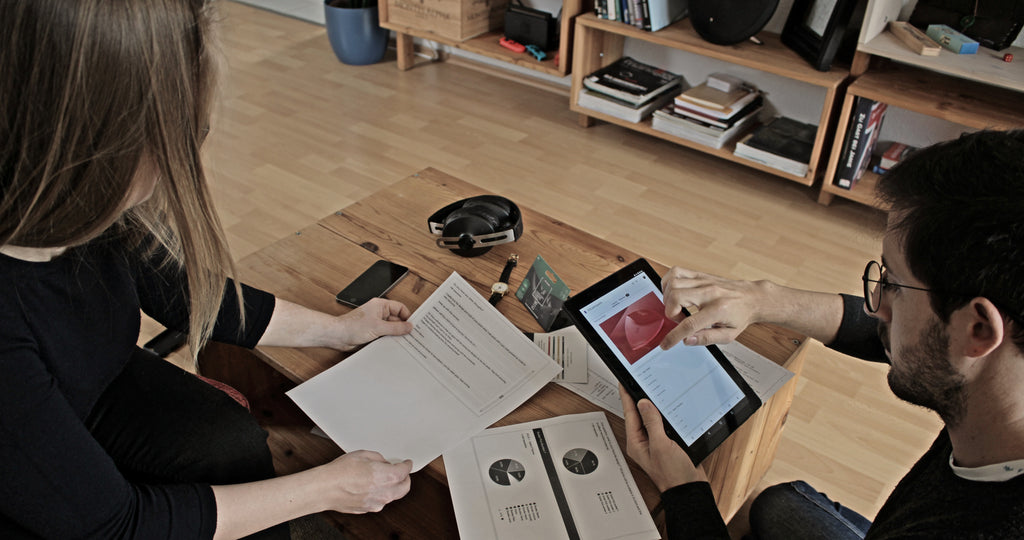
What is a signature guitar pick:
Signature guitar picks are common in the guitar pick world.
These picks were developed with the help of some expert and famous guitarists from a specific music field.
From our point of view, this is a very narrow design path that only considers the opinion and guitar playing style of one person.
Our approach: The opposite of a signature pick:
The guitar community has strongly supported Rombopicks since its beginning in 2019.
We did not want to create new guitar picks without asking the people who have been with us since the beginning. You guys and girls are the core of Rombo, and you should decide which products we develop.
The most logical step was to create a big survey to allow users to tell us how they prefer their guitar picks.
We think this is the only way to develop our guitar picks, based on the wants of our users, allowing us to make essential decisions about our company's direction.

This is only possible by listening to the thoughts of every guitar player.
In addition, by asking precise questions about guitar picks, we are able to create more awareness of complex issues, like: Why are guitar picks thick or thin? How they behave when the size changes? Does the flexibility of a guitar pick affect the tone? What about the material?
When the user is aware of the product features, he/she can deliver a useful vote.
Since the beginning, we have been researching all these areas and are sharing them with you. With every article about plectrums we have written, we have contributed to the knowledge you have about your gear so you will be able to decide which gear is the best for you and understand why.
The results of the survey:
Participants:
1.552 guitar players (including us) have participated in the survey and therefore have took part in the design process of these new guitar picks for 2021.
336 of them left a private message with detailed information.

What is your favorite guitar pick design?
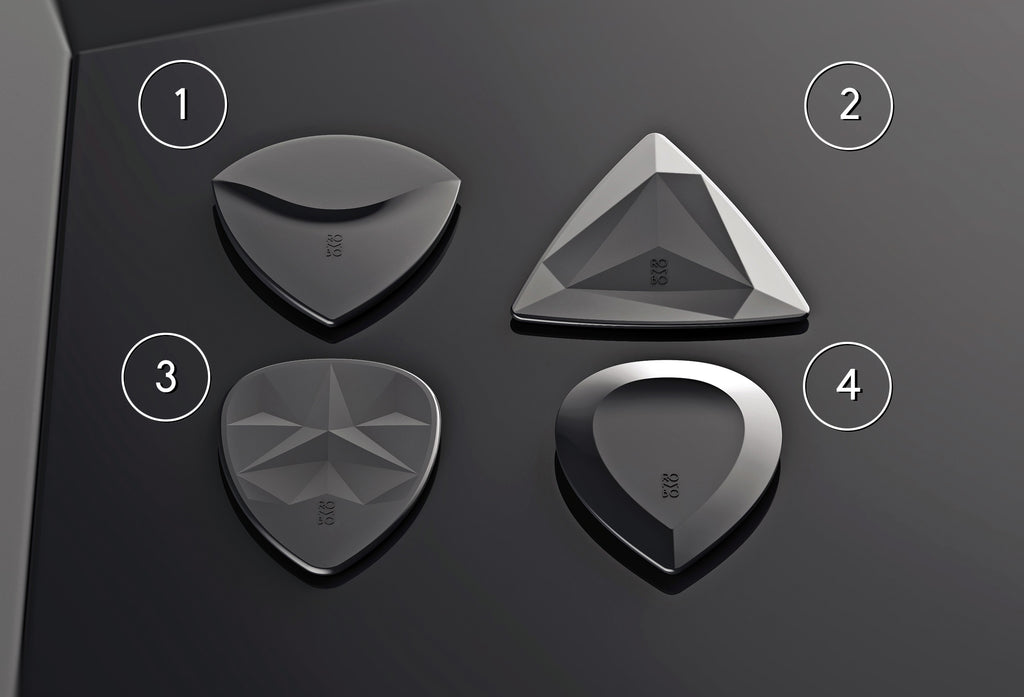
Pick number1: 18,8%
Pick number 2: 14,8%
Pick number 3: 27,8%
Pick number 4: 38,7%
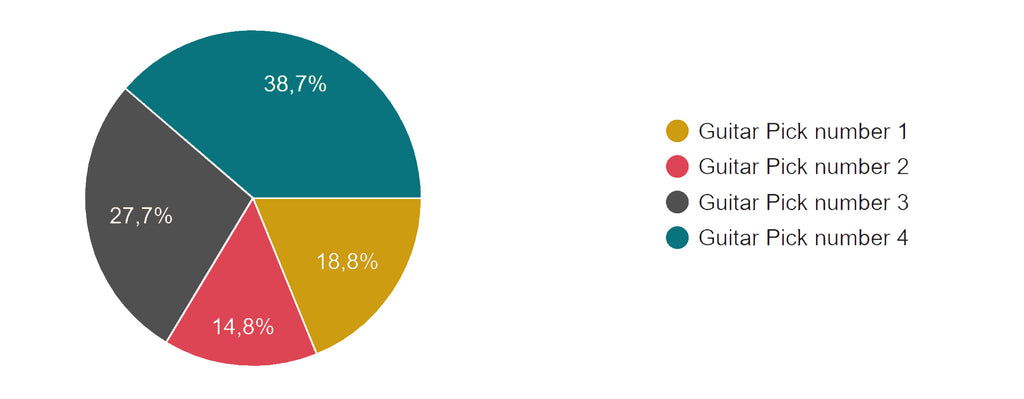
Guitar Pick Number 1:

Name:
Rombo Horizon: 34,5%
Rombo Sense. 33,9%
Rombo Summit: 14,1%
Rombo Mood: 7%
Other names: 10,5%
Average Thickness: 1,378 mm
Average Size: Medium Size with 71% of the votes
Guitar Pick Number 2:

Name:
Rombo Prisma: 76%
Rombo Spin: 7,7%
Rombo Treble: 8,4%
Other names: 7,9%
Average Thickness: 0,831 mm
Average Size: Large Size with 73,5% of the votes
Guitar Pick Number 3:

Name:
Rombo Crisp: 47%
Rombo Split: 22,1%
Rombo Prisma: 16,4%
Other names: 14,5%
Average Thickness: 1,028 mm
Average Size: Medium Size with 59,7% of the votes
Guitar Pick Number 4:

Name:
Rombo Jade: 33%
Rombo Shift: 17,6%
Rombo Slope: 12%
Rombo Summit: 10%
Rombo Dune: 7%
Rombo Cascade: 7%
Rombo Wizzard: 4,9%
Other names: 8,5%
Average Thickness: 2,37 mm
Average Size: Small Size with 56,6% of the votes
Guitar picks: Personal thoughts of 336 guitar players

A total of 336 people left us a private message regarding guitar picks.
We have read all of them carefully and we will use all this information during the development.
Here are the important questions we have received and our comments to them:
-
Will the guitar picks be available in new colors?
Not at the moment. However, we are thinking about creating some additional colors for special editions in the future.
-
Will they have the same grip structure?
Yes! Definitely. Lots of people have sent us e-mails and letters regarding the grip structure. With the micro-nodules, we have the advantage of medium-grip surfaces which add lots of control.
However, a very small number of people want the picks to have more grip. We had to make a decision here, and it was hard.
We won’t forget this topic: In the future, we want to develop a texture with more grip for these players.
-
Why don’t you create different guitar pick thicknesses for each one of the models?
We want every guitar pick to be unique. As every person has unique preferences, we believe every guitar pick should have its own design.
In the future, we hope to be able to create a bigger quantity of different plectrum designs to cover each possible necessity.
-
What about picks for bass players?
Most our picks are compatible with bass, as we have confirmed this with some bassists that are using them regularly, especially Rombo Diamond ad Rombo Origami. We explained this HERE.
-
You should create some merch, T-Shirts and other stuff:
Maybe in the future. Now, we want to focus 100% on the development of the guitar picks. Every minute we spend on the design of a T-Shirt will be taken away from the quality of the picks! ;)
-
Will you offer the EcoBlack range in other colors?
The EcoBlack material can only be produced in one color at the moment. The recycling process creates a very dark pigmentation. The industry is working hard to find a way to create new recycling processes. We hope we will manufacture all of our picks out of recycled material in the future.
When will be the new picks available?

The new guitar picks will be available in early 2021.
If you want to receive an E-Mail as soon as the picks are availabe, join our mailing list below on the footer.
This is the timeline we created for this project:

The pre-order product launch will be on the platform Kickstarter (like the first generation of Rombo guitar picks we launched in January 2019).
However, the current development of the Covid-19 could postpone the project a couple of months. We want to launch the product when we are able to deliver worldwide.
Why Kickstarter?
Kickstarter campaigns turn dreams and ideas into reality. Rombo is still a small start-up run by two people, and with limited access to resources. Through Kickstarter, we involve the community of guitar players, showing our guitar picks before launching.
This process brings us in contact with the real guitar players and their necessities. It forces us to remain flexible, accept changes, and challenges us to create new designs to fulfill the expectations of our audience.
We love open and critical criticism, and this is the best place to get it, where all comments and thoughts are visible. By sharing your experiences, we can listen to your needs and wishes, and create guitar picks that make a difference.

Guitar Pick Grip: Why Textures On Guitar Pick Surfaces Can Help Improve Your Playing Experience
The surface of a guitar pick is in direct contact with your fingers. You feel it when you hold your pick, and your guitar strings will touch the surfaces every time you play a chord or a guitar solo.
Textures on guitar picks define not only important things like grip, control, and friction between the strings and guitar pick, but also equally important details like comfort, pick noise, and design.

Why Should The Different Areas Of The Guitar Pick Have Different Texture Types?
The guitar pick consists of two areas: The hold area (body), and the attack area (tip).
Both areas have different requirements. Generally speaking, when combining the proper textures of these two areas, a guitar pick should offer:
- a comfortable surface to hold the pick securely
- a well-designed tip to promote precision

With this simple fact in mind, it seems logical to differentiate these two areas when it comes to choosing the texture of the guitar pick.
Guitar Pick Hold Area:
The body of the guitar pick is the part of the plectrum, which you use to hold it.The textures on the body will directly affect:
- the control of the guitar pick
- the grip of the guitar pick
- the comfort of the guitar pick
These three features are strictly connected and every guitar player will have a very subjective opinion of them.
Guitar Picks With Grippy Surface:
These are specifically designed guitar picks. These guitar picks won’t slip so easily and the texture on the hold area will provide the guitar player with enough grip.
Advantages Of Guitar Picks With Grippy Surfaces:
-
Control the position of the pick between your fingers: avoid rotation and pick slippage.
-
Hold the pick with less tension, which results in a better playing experience and less hand fatigue.
Common Types Of Grippy Guitar Picks:

-
Sandpaper grip: Maximum grip, very aggressive texture (uncomfortable for long playing sessions)
-
Raised geometries or logos: High grip, aggressive texture (can feel uncomfortable for long playing sessions).
-
Micro-nodules texture: Medium/High grip, comfortable texture (the micro-nodules fit between the grooves of your skin). Read more here.
-
Grip Holes: Medium Grip
-
Homemade guitar pick grip: Some players use tape or make scratches on the pick to create a custom experience.
It is up to you to find a balance between comfort and grip. Some players prefer non-sticky guitar picks, some others need the maximum grip available.
The best thing you can do is try all different textures and decide yourself, considering the playing style you have.
For guitar sessions for over 1 hour, I prefer comfort over the grip. Once you get used to the guitar pick and how it reacts after every impact, you appreciate the comfort more and the playing experience texture and design can give you.
Guitar Pick Attack Area:
The texture on the tip of the plectrum will have a direct influence on:- Durability
- Pick Noise
The texture on this guitar pick area is one of the most undiscovered features in the guitar pick world. Read more here.
How can a polished guitar pick improve durability and reduce noise?
Actually, it is very simple: A mirror polished guitar pick will reduce friction between guitar pick and strings. With every impact, the guitar pick will suffer less friction and therefore wear down slower.
With less friction, the pick will cause less pick noise. From my own experience, guitar picks with this attribute make me want to play forever.
In addition, the pick will glide better and provide a better playing experience. However, this is a very subjective point since other types of guitar picks with coarse textures on the tip are very popular amongst some guitarists. Pick noise is sometimes wanted when strumming chords.
Bonus Feature: Unique Designs:
This is a bonus argument I always use: Combining different textures in one pick can be very useful for creating unique designs.Guitar pick surfaces not only affect the function, but also the aesthetics.
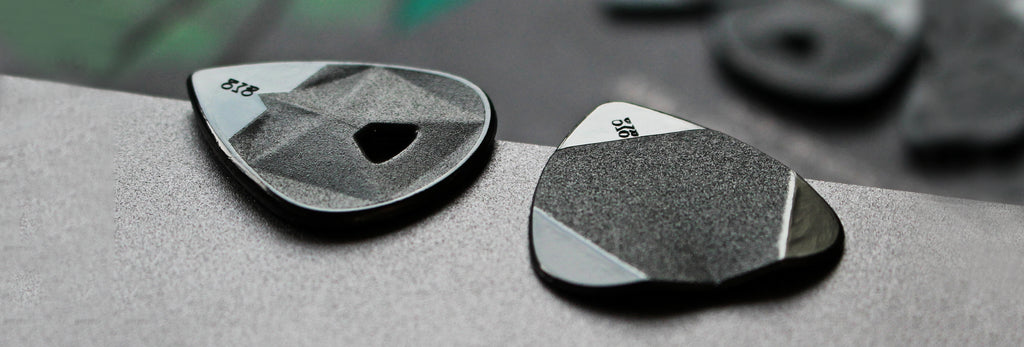
In order to build your own image, you need gear that fits in it. Design is as important as the other aspects when it comes to music gear.
Fortunately, we live in an era where many brands are creating very original designs with the best functionality.
Guitar Pick Grip: What Textures Are We Using At Rombo?
We believe textures on guitar picks are essential for a tool that was designed to be held between your fingers
The combination of two different surface finishes in the guitar picks have convinced us and our testers of the potential gains a player can achieve:
- A polished tip for clarity, durability and control
- A micro-nodules texture in the centre of the guitar pick for the most comfortable holding without compromising grip
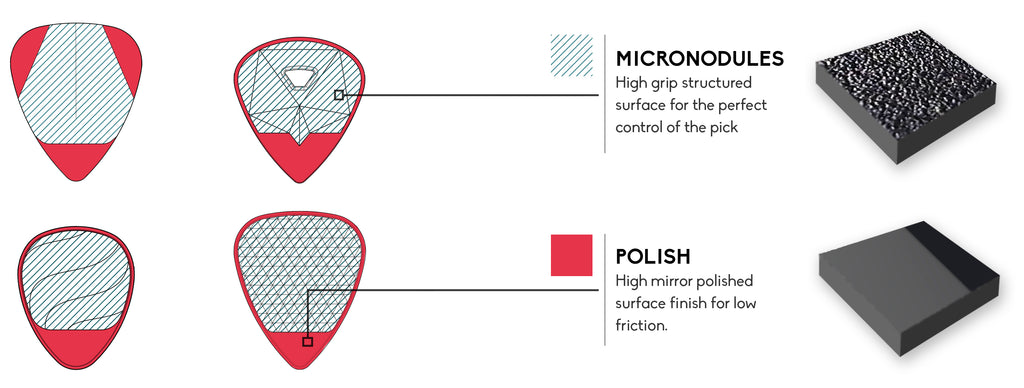
Conclusion:
Grippy textures can help you hold the guitar pick more firmly without effort.
Looking for a texture you feel comfortable with is essential to find the balance between grip and comfort.
However, what about thickness, shape, size, and material? Have you thought about these attributes?
Learn more in our article "How to choose the right guitar pick".

- Shop
- Dealers
- Legal Notice
- Terms of Service
- Refund Policy
- Shipping
- Privacy Policy
- Contact us
- Press
- FAQ
Sign up to get the latest on sales, new releases and more…
By signing up you agree to our privacy policy.
© 2025 ROMBO.
registered brand
Powered by Shopify

